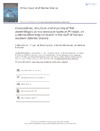Identificador persistente para citar o vincular este elemento:
https://accedacris.ulpgc.es/jspui/handle/10553/77033
| Título: | Composition, structure and diversity of fish assemblages across seascape types at Príncipe, an understudied tropical island in the Gulf of Guinea (eastern Atlantic Ocean) | Autores/as: | Otero-Ferrer, F. Tuya Cortés, Fernando José Bosch Guerra, Néstor Echedey Herrero-Barrencua, A. Abreu, A. D. Haroun, R. |
Clasificación UNESCO: | 240119 Zoología marina | Palabras clave: | Biodiversity Conservation Ecotones Equatorial West Africa Ichthyofauna, et al. |
Fecha de publicación: | 2020 | Publicación seriada: | African Journal of Marine Science | Resumen: | Coastal seascapes are often composed of a mosaic of interconnected habitats. Transitions between adjacent habitats are of special relevance to the ecology of many reef-associated organisms. In this study, we tested (i) whether the degree of similarity in the composition and structure of coastal fish assemblages differed between three interconnected seascape types, and (ii) whether differences in taxonomic and phylogenetic diversity of the fish assemblages were consistent between the seascape types. We sampled fish species from diverse habitats in the shallow coastal waters surrounding the island of Príncipe (Gulf of Guinea, eastern Atlantic Ocean), an understudied and remote tropical island. Specifically, video transects were carried out by SCUBA divers at three seascape types: rocky reefs, rocky reef–rhodolith bed transitions, and rocky reef–sandy bottom transitions, to extract presence/absence and ordinal abundance data, across a range of depths (9–31 m), covering the entire perimeter of the island. A total of 71 fish taxa were recorded. Both the composition and structure of the fish assemblages differed between the studied seascapes. The mean number of fish species (taxonomic diversity) was higher on ‘reefs’ than in both the ‘reef–rhodolith bed’ and ‘reef–sandy bottom’ transitions. In contrast, the taxonomic distinctness index (phylogenetic diversity) was higher for fish assemblages in both transitional seascape types than on rocky reefs. Hence, at the island-scale, the protection of local fish assemblages needs to consider a representative network of interconnected habitats, including at these seascapes boundaries where important ecological functions seem to occur. | URI: | https://accedacris.ulpgc.es/handle/10553/77033 | ISSN: | 1814-232X | DOI: | 10.2989/1814232X.2020.1826358 | Fuente: | African Journal of Marine Science [ISSN 1814-232X], v. 42 (4), p. 381-391, (Diciembre 2020) |
| Colección: | Artículos |
Citas SCOPUSTM
5
actualizado el 08-jun-2025
Citas de WEB OF SCIENCETM
Citations
4
actualizado el 08-jun-2025
Visitas
131
actualizado el 31-may-2025
Descargas
409
actualizado el 31-may-2025
Google ScholarTM
Verifica
Altmetric
Comparte
Exporta metadatos
Los elementos en ULPGC accedaCRIS están protegidos por derechos de autor con todos los derechos reservados, a menos que se indique lo contrario.
